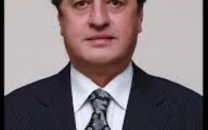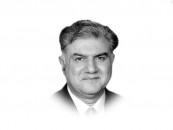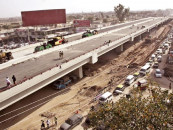Restructuring the military system
Pakistan’s military reforms must preserve unity of command, avoid bureaucratic control over emerging warfighting tools

Unambiguous command and control is the key to effective use of the military instrument. This principle cannot be violated in a military system that must always be war-ready. The Services structure is built on those lines with minor variations, if any. As technology improves or is inducted with capability enhancement, it remains housed under the same construct responsible for it in the first place.
Slight tweaking to add specialisation if needed only strengthens the system of optimal employment and effective utilisation. Unity of commands is thus ensured, even in the most diverse capabilities. Any major change to the command and control in the military is made only if it makes the response more efficient and effective. Laborious and weighty bureaucracy is anathema to the military's effective and optimal employment.
Pakistan's military system, despite two superfluous nomenclatures — the Supreme Commander, which is more symbolic, and the Chairman JCSC, now rescinded — has retained its integrity very effectively. Slight issues of synergy and integration were overcome with experience and a better understanding of one another. The system has worked well and delivered well to date. As we stand on the verge of another tweak, we need to be conscious of the pitfalls that may, over time, creep into the system, slowing its effectiveness and optimal employment. This is how it can be done.
Technology has enabled newer and more effective tools of war that can bring about a synergistic employment of assets, resulting in force multiplication. The short skirmish with India over four days established the inevitability of force fusion and cooperative and coordinated employment. Nothing stands out more starkly than in campaign planning for missions by the Air Force.
The PAF leadership, over the years, successfully comprehended the nature of the modern war and began preparing for it through equipment, platform and capability acquisition cycles that led to how the air force stood before May 2025. Training its manpower to prepare for such synergy in a massively different combat environment — in anticipation of the planned inductions — meant that it was ready for the modern war as soon as newer tools and technologies arrived as a capability.
It helps to understand the planning cycle of a mission in the Air Force. Certain capabilities are organic to the Service, which remains the first responder as well as the primary tool of instant reprisal to provocation of an enemy offensive. Over time, it remains the most effective tool of pain and punishment to the enemy, and now a major source of embarrassment to the enemy because nothing in today's world can be hidden in wraps.
The capabilities are woven into one organic function, each timed to perfection, with responsibility for each delineated to be injected at the precise moment. Liken it to a music sheet, where each player reads from the planned sheet and the moment to add his/her voice/sound to complete the symphony. There is little time to go looking for the right sound when you need to be playing it. This is only possible if each lives with the other in a tactical surrounding that is home to all. Sporadic or casual engagements do not create a common language or ethos of a common purpose unless they live that purpose together.
Whatever capabilities were integrated into the campaign plan between May 6 and 10, 2025, must remain organically available to the force commander at the tactical level to deliver the full punch with effect and efficiency. It keeps the force safe and strong in the face of multifarious threats that array against such force employment. That is the principle and the rule.
For optimal effect and unqualified success, it must be followed religiously. No supra-body must interfere with this imperative for successful employment of force. Timed and instantaneous intervention must remain available to the operational and tactical commander for injection at critical junctures in the mission. Decision-making in aerial combat is delegated to the lowest level to the man in the cockpit and the tactical commander of the mission. It does not afford time to negotiate its availability. This rule must never be violated.
As technology gallops and becomes part of war-fighting, more platforms add to the operational capability. Space and Cyber are the new frontiers and have multifaceted dividends, from economic to strategic to operational and tactical. These need intimate technical knowledge and the ability to refine them for operational and tactical use in specific conditions.
It is essential that, as we develop these into organised sectors and as a more widely used national-level resource, we do not place these under a generalised bureaucratic management. There should never be a situation for a commander at the operational or tactical level to requisition these and then wait for approval. If we go that way, we will be blindly following India in that alley of bureaucratic control to a zero-sum result. We must keep the possession and control of these niche and exclusive capabilities in the charge of the tactical commander who can use these to optimal effect.
The position of Commander of a National Strategic Command should encompass the current functions of the SPD, leaving operational control of Strategic Forces with the respective Services HQs. Additionally, the newly formed Rocket/Missile Force can be subdivided into a part under the Army and another under the new post. SUPARCO, which is the founding centre for all matters related to Space, and a national-level activity, must too be placed under the Strategic Commander.
Except that Services now also have independent and mission-specific needs for indigenously developed capabilities that reside in Space. Equally, there are capabilities in each of these avenues to serve national purpose, economic or any other, which may fall under the designated National Strategic Commander. Such distinction in command and control, in actual possession of the capability, and the freedom to integrate these in war plans, must not only be assured, it must be jealously guarded.
The more crowded it gets at the top, the greater can be the friction. This will defeat the purpose of such a major tweak aimed at gaining better synergy and integration. Similarly, two independent Services, each with its specialised function and responsibility, are led by respective four-star ranks. Creating more four-star positions will only dilute the impact of their respective positions within their service and within the military system. The position of the VCOAS is more incidental and is typically used in specific situations. Both Generals, Zia and Musharraf, used the posts when they were concurrently Presidents.
Smarter and leaner the services, which inevitably must come with greater automation and induction of emerging technologies, the sharper is their bite. Volume now must only cater to the spread and diversity of employment, and within that, retain the principle of sharper and leaner structures. Pakistan has open fronts that the military is directly engaged in. It must, thus, gingerly tread through without becoming overwhelmingly voluminous and unwieldy.















COMMENTS (2)
Comments are moderated and generally will be posted if they are on-topic and not abusive.
For more information, please see our Comments FAQ